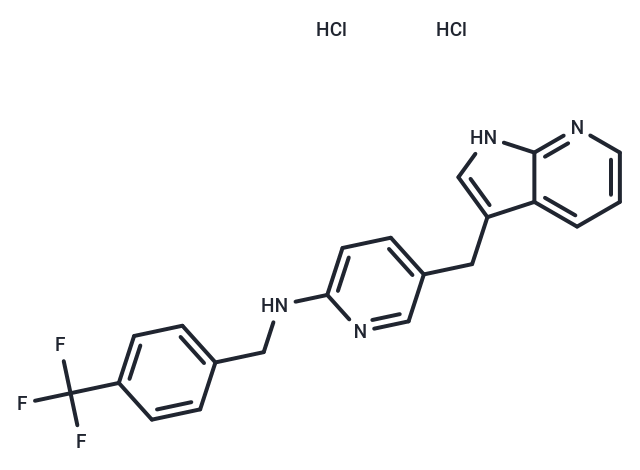Shopping Cart
Remove All Your shopping cart is currently empty
Your shopping cart is currently empty
PLX647 dihydrochloride is a potent and selective dual inhibitor of FMS and KIT kinases, with IC50 values of 28 nM and 16 nM, respectively. At a concentration of 1 μM, PLX647 dihydrochloride demonstrates superior selectivity against a wide range of 400 kinases, except FLT3 and KDR, where IC50 values are 91 nM and 130 nM, respectively. This orally active compound holds great potential for targeted kinase inhibition.

| Pack Size | Price | USA Warehouse | Global Warehouse | Quantity |
|---|---|---|---|---|
| 5 mg | $970 | Inquiry | Inquiry |
| Description | PLX647 dihydrochloride is a potent and selective dual inhibitor of FMS and KIT kinases, with IC50 values of 28 nM and 16 nM, respectively. At a concentration of 1 μM, PLX647 dihydrochloride demonstrates superior selectivity against a wide range of 400 kinases, except FLT3 and KDR, where IC50 values are 91 nM and 130 nM, respectively. This orally active compound holds great potential for targeted kinase inhibition. |
| In vitro | In vitro, PLX647 dihydrochloride demonstrates significant inhibitory effects on the proliferation of various cells. It potently halts the growth of BCR-FMS cells with an IC 50 of 92 nM, and shows similar potency towards a Ba/F3 cell line expressing BCR-KIT, presenting an IC 50 of 180 nM. This compound also effectively suppresses endogenous FMS and KIT signaling, indicated by its ability to inhibit M-NFS-60 and M-07e cell lines, which express FMS and KIT, respectively, with IC 50 values of 380 nM and 230 nM. Additionally, PLX647 dihydrochloride significantly inhibits FLT3-ITD-expressing MV4-11 cells with an IC 50 of 110 nM, but it exerts minimal inhibition on the proliferation of Ba/F3 cells expressing BCR-KDR, with an IC 50 of 5 μM. Moreover, this compound inhibits osteoclast differentiation, marked by an IC 50 of 0.17 μM. |
| In vivo | PLX647 dihydrochloride administered at 40 mg/kg orally, twice daily for 7 days, significantly reduces macrophage accumulation in unilateral ureter obstruction (UUO) kidney and blood monocytes, as well as decreasing LPS-induced TNF-α and IL-6 release in male Swiss Webster mice. Further, dosages ranging from 20-80 mg/kg administered orally daily or twice daily from days 27 to 41 demonstrate efficacy in collagen-induced arthritis models in mice, with 20 mg/kg showing no initial effect but eventually inhibiting the macroscopic signs of arthritis by 30% on day 41, while 80 mg/kg results in a 76% reversal of disease severity by the same day. At a 30 mg/kg dosage, PLX647 dihydrochloride notably inhibits TRAP5b immunostaining and bone osteolysis, and effectively prevents bone damage caused by tumor cells. In a mouse unilateral ureter obstruction model using male C57BL/6 mice, the administration resulted in a 77% reduction in F4/80+ macrophages after 7 days. In a mouse collagen-induced arthritis model with 7-9 week old male DBA/1J mice, the compound at 20 mg/kg showed no initial therapeutic effect, but from day 33, halted further development of severe arthritis, whereas at 80 mg/kg, it delayed the onset and significantly reduced arthritic signs from day 33, achieving a noteworthy reversal by day 41. |
| Molecular Weight | 455.31 |
| Formula | C21H19Cl2F3N4 |
| Cas No. | 1779796-38-1 |
| Relative Density. | no data available |
| Storage | Powder: -20°C for 3 years | In solvent: -80°C for 1 year | Shipping with blue ice/Shipping at ambient temperature. |
| Size | Quantity | Unit Price | Amount | Operation |
|---|

Copyright © 2015-2025 TargetMol Chemicals Inc. All Rights Reserved.